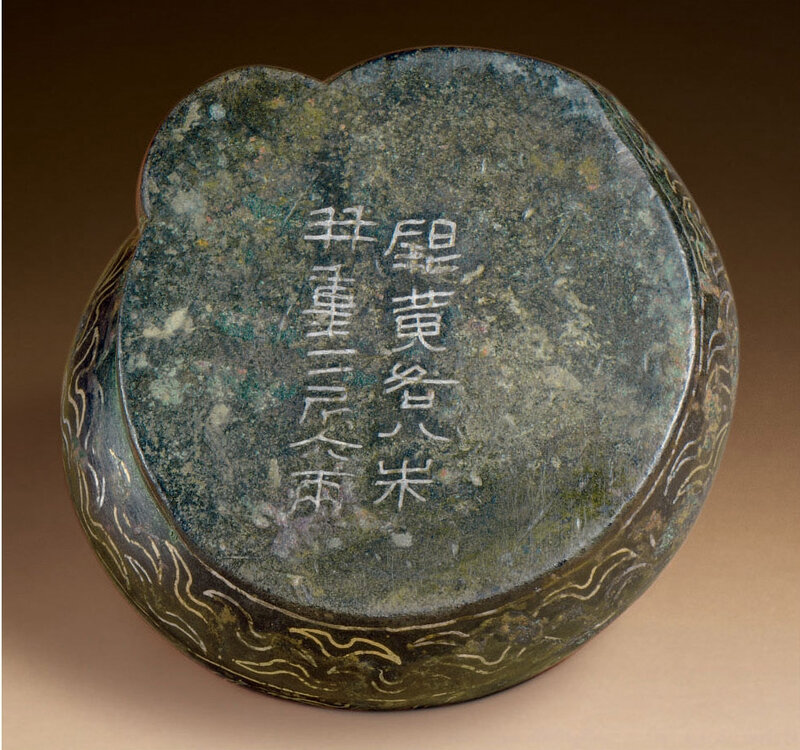Christie's. The Sze Yuan Tang Archaic Bronzes from the Anthony Hardy Collection, New York, 16 September 2010
A rare gold and silver-inlaid bronze tiger-form weight, Eastern Han dynasty (25-220 AD)
Lot 886. A rare gold and silver-inlaid bronze tiger-form weight, Eastern Han dynasty (25-220 AD); 2 5/8 in. (6.7 cm.) across. Estimate 60,000 - USD 80,000 USD. Price realised 182,500 USD. © Christie's Image Ltd 2010.
The solid-cast figure shown in a tightly coiled recumbent position with head raised in a menacing attitude, finely inlaid in silver and gold with facial features and stripes, the flat base inlaid in silver with an eleven-character inscription arranged in two lines, which gives the weight of the gold and silver used and the weight of the finished object, box.
Provenance: Acquired in Hong Kong, 1988.
Exhibited: Ancient Chinese and Ordos Bronzes, Hong Kong Museum of Art, 1990, no. 115.
The Glorious Traditions of Chinese Bronzes, Singapore, 2000, no. 96.
Metal, Wood, Water, Fire and Earth, Hong Kong Museum of Art, 2002-2006.
Note: The inscription may be read, "Yin huang ge ba zhu/Bing zhang er jin liu liang". The inscription refers to the silver and gold used in the inlay and the quantity used, "eight zhu", as well as the weight of the finished object, "two jin and six liang". As the weight today is 501.5 g., it can be calculated that a jin must have been 236.42 g.
Weights of this type, made during the Warring States period and Han dynasty, appear to have been used to hold down the corners of woven mats used for seating or for the board game liubo. They were usually made in the shape of animals, often coiled to form a circle, or in the shape of human figures, and even mountains. They were usually made of bronze, and often sumptuously decorated in gilding, or inlaid with gold, silver and gemstones to convey the high social status of the owner.
This rare and finely inlaid weight is stylistically similar to another tiger-shaped weight inlaid in silver sheet with stripes, sold in these rooms, 2 December 1985, lot 87. The same coiled feline shape can be seen in a pair of gilt-bronze weights, and in a set of four agate weights, all dated Western Han dynasty, illustrated by M. Wang et al., in the exhibition catalogue, A Bronze Menagerie: Mat Weights of Early China, Isabella Stewart Gardner Museum, Boston, 2006, pp. 76-7, nos. 1 and 2.

/https%3A%2F%2Fprofilepics.canalblog.com%2Fprofilepics%2F1%2F0%2F100183.jpg)
/https%3A%2F%2Fstorage.canalblog.com%2F03%2F02%2F119589%2F96711876_o.jpg)
/https%3A%2F%2Fstorage.canalblog.com%2F11%2F31%2F119589%2F94773502_o.jpg)
/https%3A%2F%2Fstorage.canalblog.com%2F20%2F83%2F119589%2F94772815_o.jpg)
/https%3A%2F%2Fstorage.canalblog.com%2F26%2F72%2F119589%2F75604929_o.jpg)
/https%3A%2F%2Fstorage.canalblog.com%2F59%2F60%2F119589%2F26458628_o.jpg)




/http%3A%2F%2Fstorage.canalblog.com%2F63%2F62%2F119589%2F129536091_o.jpg)
/http%3A%2F%2Fstorage.canalblog.com%2F24%2F84%2F119589%2F129084531_o.jpg)
/http%3A%2F%2Fstorage.canalblog.com%2F26%2F98%2F119589%2F127972323_o.jpg)
/http%3A%2F%2Fstorage.canalblog.com%2F38%2F89%2F119589%2F126803657_o.jpg)